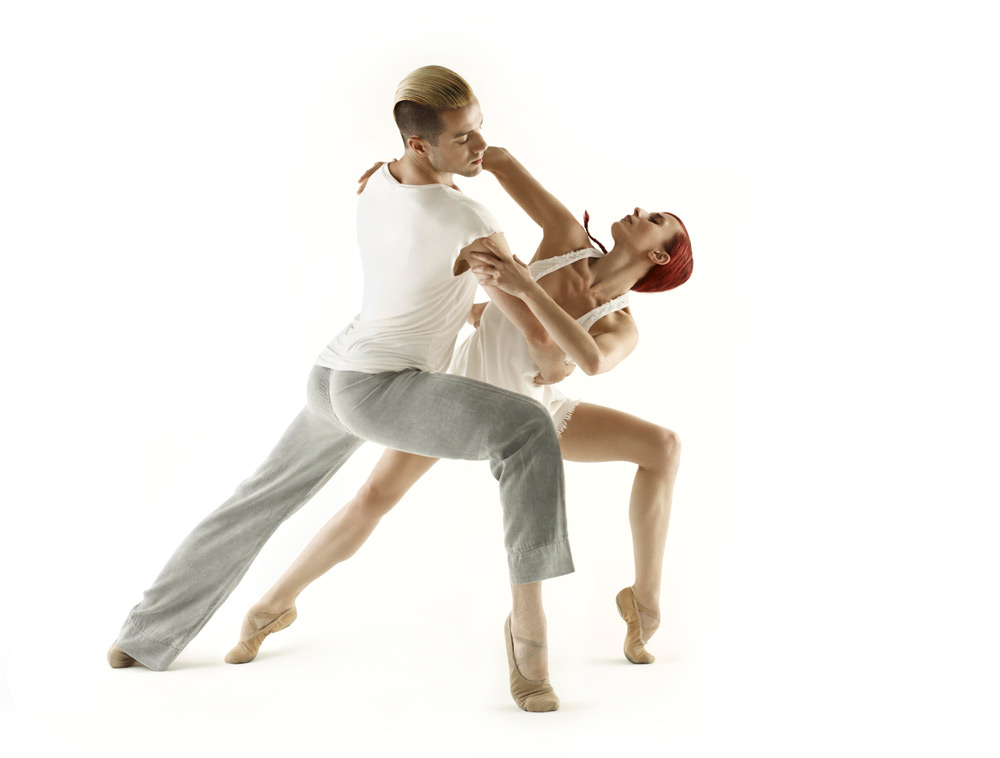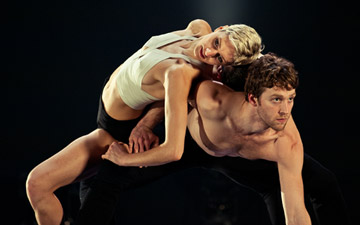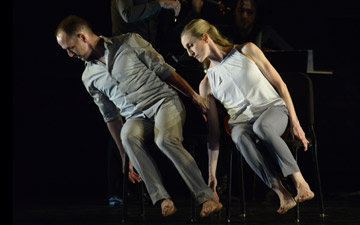
© Rennie Harris Puremovement. (Click image for larger version)
Fall For Dance Festival – Program 4
Brian Brooks Moving Dance Company: Torrent
Australian Ballet: Ostinato
Les Ballets Jazz de Montreal: Closer
Rennie Harris Puremovement: Students of the Asphalt Jungle
New York, City Center
11 October 2012
nycitycenter.org
Fall For Dance took off with a rip-roaring start this year, but, with the exception of Rennie Harris Puremovement’s rousing hip-hop theater, Program 4 was a little lackluster.
Students of the Asphalt Jungle opens with nine shirtless men walking onstage with a regal gait, their pumped pecs glistening under the lights like so many Egyptian gods. The calling card piece for Rennie Harris Puremovement, Students exemplifies what the troupe stands for: classy, non-commercial hip-hop with a respectful nod to history. The work receives strong vocal response from the audience, not only because the genre allows it, but because of the athleticism, which is on a par with the most difficult gymnastics routine. Ensemble choreography is interspersed with a very welcome high number of improvised solos incorporating high leaps, dizzying spins and otherworldly breakdancing moves. Dating from 1996, Students holds up because its dancers are impressive, the improvisation allows for fresh moves, and the entire package is so jubilant you’d have to lack a pulse to not enjoy it. There is an undeniable integrity in work that communicates the sheer joy of dance, of movement, of being born into a human body. Refreshingly unpretentious, Students is nothing but the purest proof that hip-hop choreography is just as polished an art form as any other, and with its constant commitment to innovation, its future could not be brighter. Although long embraced by pop culture, hip-hop and urban dance are still trying to win over more traditional audiences and fight harder than they should for bookings in traditional venues. If Saturday night’s standing ovation was anything to go by, the audience is there.

© Bob Emott. (Click image for larger version)
In a collaboration with Julliard Dance, Brian Brooks Moving Company presented Torrent, a fairly recent piece that premiered last December. Using a large number of dancers, the work somehow manages to give both the sensation of falling off a cliff and drowning in the ocean – a mixed metaphor. Dancers run downstage in, well, a torrent, and line up before you like little dots, one after the other before peeling away, one by one, reversing the sequence. The costumes are casual and mismatched, hairstyles are personal and at random (the longer and freer the hair, the more distracting), and the continual lilting and teetering leaves the geometry muddled. Brooks relies heavily on his own personal vocabulary, akin to a certain sign language, with hands touching wrists and elbows in quick sequences, gestures which add little structural or choreographic merit. The attitudes are inconsistent, some dancers smile, others are serious, while many take on a vague attempt at being profound – the vacant, wide-eyed stare of an indie film star. When those looks serve a purpose, that’s one thing, but the spotty application of them exudes vapidity.

© Rosalie O’Connor. (Click image for larger version)
Speaking of superficial emotion, Benjamin Millepied’s long and labored Closer, as presented by Les Ballets Jazz de Montreal, is full of it. Maybe superficial isn’t quite the right word, but it’s certainly close. Given the title, Millepied clearly wants the audience to believe in the “ballet sex” that is happening on stage. He wants us to feel it, to turn us into voyeurs and hopes we’ll invest in it. And while the graphic choreography makes the sex believable, the intimacy is not – or it wasn’t on Friday night. It didn’t help that Alexander Hille, partnering Céline Cassone, was a cold fish – not that his choreography gave him much to do. While Cassone’s visage was frequently overwrought with vaguely tortured expressions, Hille’s was as stony as a statue. If this was the dramatic direction, and not a Friday night fluke, it’s more than a little sexist to both sexes. While this could be a casting and chemistry issue, the costumes – Cassone in panties and a camisole, Hille in baggy sweatpants and a T-shirt – reinforce the stereotype of a vulnerable, exposed female and a cryptic, unrevealing male. Despite its choreographic attempts to communicate the opposite, Closer feels cold, and far from sensual. There are plenty of dramatic and believable stage intimacies in the history of ballet and dance, but this isn’t one of them. Arbitrary “emo” moodiness, as sometimes exhibited in Wheeldon, McGregor, and here with Millepied, is not a substitute for dramatic skill or choreographic prowess.

© Leda & St.Jacques. (Click image for larger version)
There is a Jerome Robbins feel to Tim Harbour’s Ostinato, for Australian Ballet, which made its world premiere at this year’s festival. Set to Bill Evans’ Peace Piece, the music has the plaintive air of one of Satie’s Gymnopédies. The simple, elegant pas de trois for two men and one woman is not a blockbuster, but there’s no harm in it. There are some jazzy angles, a slide here, a diagonal there, and classy partnering. Ty King-Wall and Daniel Gaudiello are both stereotypically Australian, that is to say, hunky: King-Wall for his robust upper body, and Gaudiello for his rippling physique. King-Wall performs with a command that belies his age. Only in his mid-20’s, he was promoted to Principal status last year. While not a terribly urgent work, Ostinato is a quiet piece that ends with the dancers facing the pianist, a tasteful ode to music.

















You must be logged in to post a comment.